Intel's Haswell Architecture Analyzed: Building a New PC and a New Intel
by Anand Lal Shimpi on October 5, 2012 2:45 AM ESTPlatform Retargeting
Since the introduction of Conroe/Merom back in 2006 Intel has been prioritizing notebooks for the majority of its processor designs. The TDP target for these architectures was set around 35 - 45W. Higher and lower TDPs were hit by binning and scaling voltage. The rule of thumb is a single architecture can efficiently cover an order of magnitude of TDPs. In the case of these architectures we saw them scale all the way up to 130W and all the way down to 17W.

In the middle of 2011 Intel announced its Ultrabook initiative, and at the same time mentioned that Haswell would shift Intel's notebook design target from 35 - 45W down to 10 - 20W.
At the time I didn't think too much about the new design target, but everything makes a lot more sense now. This isn't a "simple" architectural shift, it's a complete rethinking of how Intel approaches platform design. More importantly than Haswell's 10 - 20W design point, is the new expanded SoC design target. I'll get to the second part shortly.
Platform Power
There will be four client focused categories of Haswell, and I can only talk about three of them now. There are the standard voltage desktop parts, the mobile parts and the ultra-mobile parts: Haswell, Haswell M and Haswell U. There's a fourth category of Haswell that may happen but a lot is still up in the air on that line.
Of the three that Intel is talking about now, the first two (Haswell/Haswell M) don't do anything revolutionary on the platform power side. Intel is promising around a 20% reduction in platform power compared to Sandy Bridge, but not the order of magnitude improvement it promised at IDF. These platforms are still two-chip solutions with the SoC and a secondary IO chip similar to what we have today with Ivy Bridge + PCH.
It's the Haswell U/ULT parts that brings about the dramatic change. These will be a single chip solution, with part of the voltage regulation typically found on motherboards moved onto the chip's package instead. There will still be some VR components on the motherboard as far as I can tell, it's the specifics that are lacking at this point (which seems to be much of the theme of this year's IDF).
Seven years ago Intel first demonstrated working silicon with an on-chip North Bridge (now commonplace) and on-package CMOS voltage regulation:
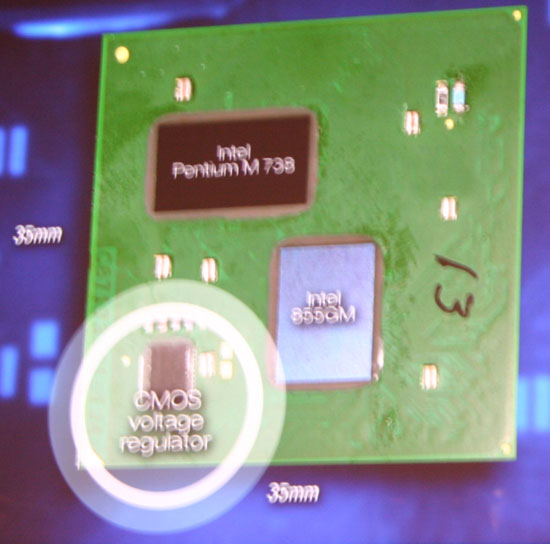
The benefits were two-fold: 1) Intel could manage fine grained voltage regulation with very fast transition times and 2) a tangible reduction in board component count.
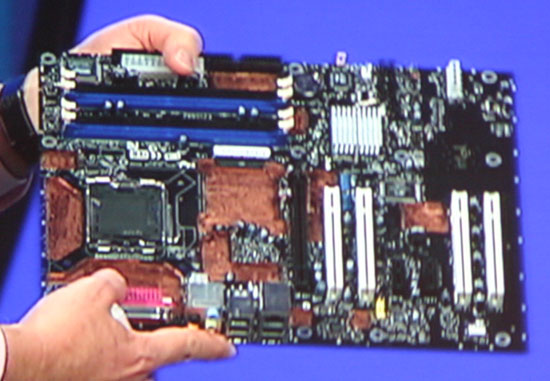
2005 - A prototype motherboard using the technology. Note the lack of voltage regulators on the motherboard and the missing GMCH (North Bridge) chip.
The second benefit is very easy to understand from a mobile perspective. Fewer components on a motherboard means smaller form factors and/or more room for other things (e.g. larger battery volume via a reduction in PCB size).
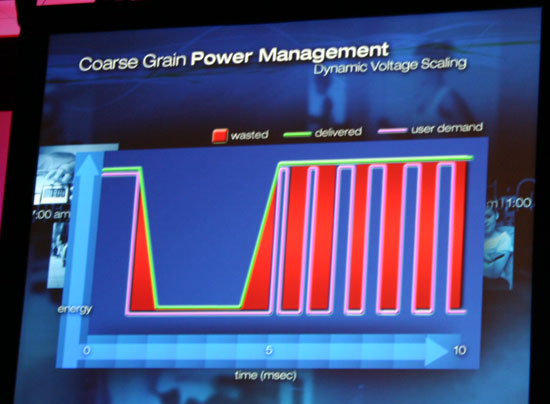

The first benefit made a lot of sense at the time when Intel introduced it, but it makes even more sense when you consider the most dramatic change to Haswell: support for S0ix active idle.


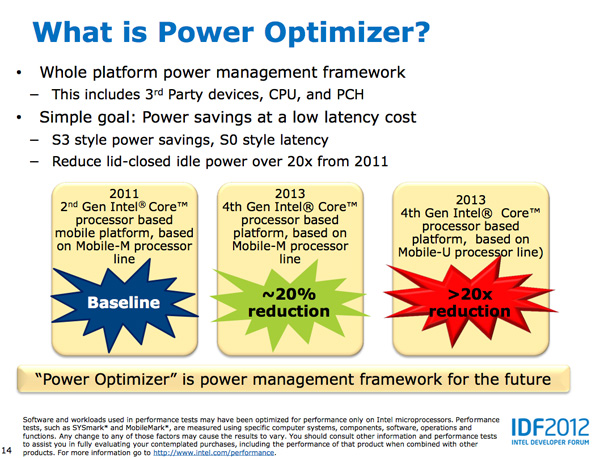
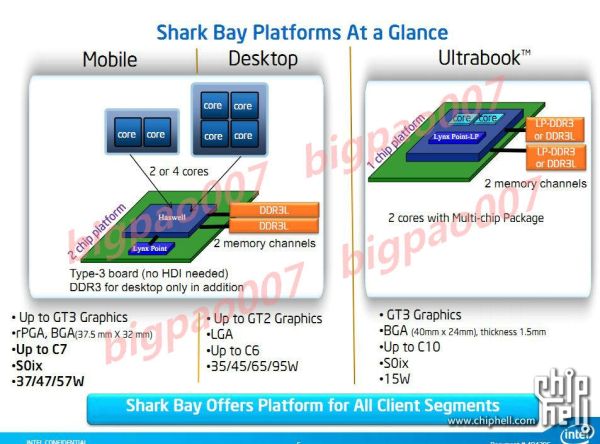








245 Comments
View All Comments
dishayu - Friday, October 5, 2012 - link
Woah! I did not even think of that. That is VERY compelling but i can't do without unlocked multiplier, so there is no perfect processor for me still :(StevoLincolnite - Friday, October 5, 2012 - link
Or just go with a Socket 2011 Core i7 3930K like I have and do a little bit of undervolting and has no IGP's.I think the reason why the Desktop space has seen decreasing/stagnant sales is simply because allot of people see no need to upgrade.
A Core 2 Quad Q6600 @ 3.6ghz, with a decent chunk of Ram and a decent graphics card is actually fairly capable of running almost every game at maximum settings.
Heck I know people who are perfectly happy sitting with a Pentium 4 for basic web use.
I think a change needs to happen where software catches up with hardware to give people a reason to upgrade and drive sales which might reinvigorate Intel and AMD to innovate.
Windows 8 and the next generation consoles might actually help in that regard.
De_Com - Friday, October 5, 2012 - link
Well said Steve. Couldn't agree with you more.
I'm running a Core 2 Extreme QX6850 at 3.4ghz, 1066Mhz DDR2 Ram and a GTX295 and it still rocks all the newest games at or close to max settings.
Will have this system 4 years this November.(all except the GTX295, which was upgraded from a 9800 GX2), even now I'm thinking that was a waste of cash.
I've gone to upgrade at least twice each year, but can't justify it.
The only place I'd see returns is in the power costs, but hey, whats a few extra cents.....
The system meets my needs, and forking out for a similar system today would cost around the €1800 mark.
Until the software can better utilize the components I'm holding out until Summer 2013, that'll be over 4 years I've gotten out of this system. Up until 2008 I slavishly upgraded every year or 2.
lukarak - Saturday, October 6, 2012 - link
This (late) December, i will have had my i7 for 4 years, and i have not seen a single reason to upgrade. The GPU is 2.5 years old (GTX480, was 280 before that).A x58 motherboard has 6 memory slots, and now houses 24 GB of ram for virtual machines, which can go 48 GB for a reasonable price.
I just don't see the need to do anything more, and this will probably fail from old age before i would need a drastically faster machine.
xaml - Thursday, May 23, 2013 - link
"but hey, whats a few extra cents....."Sure, it's probably not your generation to take the hit, having to deal with the consequences of energy excesses.
DanNeely - Friday, October 5, 2012 - link
Is that actually an IGPless chip, or just a standard LGA1155 quadcore chip with a disabled IGP.csroc - Friday, October 5, 2012 - link
I don't mind power savings, the few times my system is idle it could certainly benefit but overall it would mean reduced consumption even under load. My system just doesn't spend enough time in idle with my Q9450.Ultimately it does seem as though the software demand for faster CPU hardware has slowed and between that and the lack of real competition, so has the development.
If it weren't for the fact that I need more RAM or wanted faster photo processing (and may start doing some video) I'd probably keep what I've got a bit longer. My Q9450 hasn't held me back from playing any games yet. The 20% OC I've been running doesn't hurt but ultimately a lot of things just aren't CPU limited anymore.
Kidster3001 - Monday, October 15, 2012 - link
If you're playing 3D games then your CPU is likely "idle" 50%-75% of the time. Idle time does not just mean when the display is off.IanCutress - Friday, October 5, 2012 - link
You may think this as a result of all the low power talk, but Haswell is doing something rather important on the peak performance side. The increase in the size of the execution engine is important - adding in another integer ALU and another load/store means that in workloads that share INT and FPU performance (think loop counters which store an INT for loop iteration then perform some FP calcs) will improve. By increasing the bandwidth available and being able to keep the two FPU fed with info means a greater throughput as long as the bandwidth and thread switching can hide any additional L3 latency. Personally I'm thinking this may be a subtle move towards more threads per core in future architectures. Some of the non x86 are abusing 8 threads/core with improvement gains, so I wonder if that would be possible here. Ideally we would like every port on the execution engine to do everything, with a single pipeline feeding it and excellent branch prediction to help with single thread speed. Smaller nodes help with that silicon real estate, or someone will stumble on a better/smaller way to actually physically create these things.Ian
DanNeely - Friday, October 5, 2012 - link
I'm curious what IBM/Oracle's high SMT designs look like on the execution port side. As long as it's business as usual I doubt Intel will ever make all the ports do everything because it would just be hogging a huge amount of die area when the odds of each thread doing all of the same instruction type constantly are very low. Smaller bursts of one type can be spread out using OOOE.